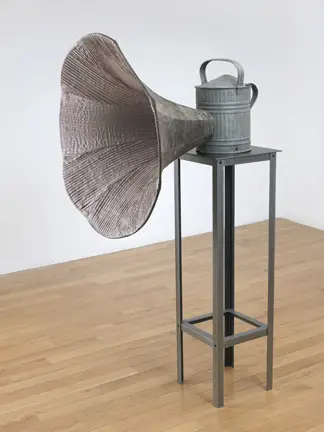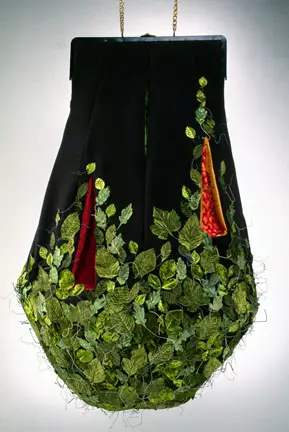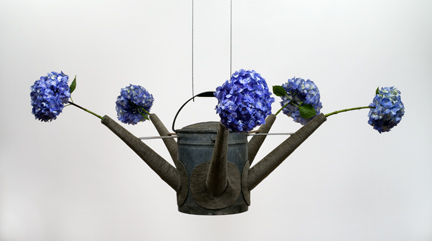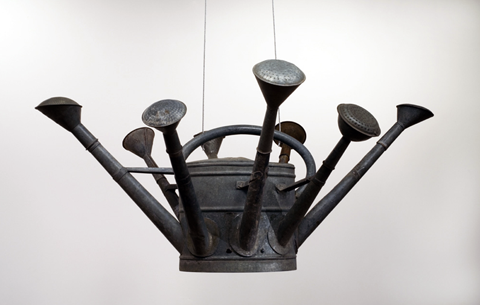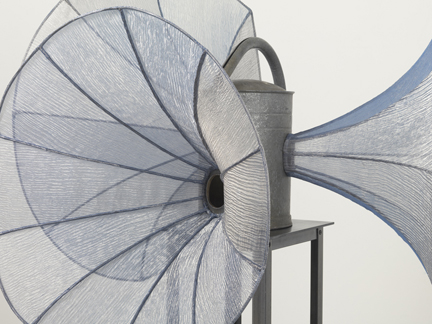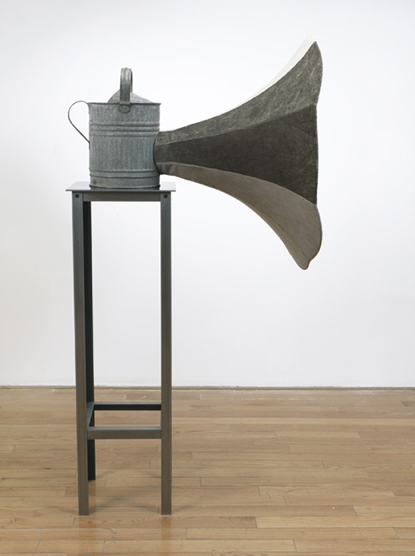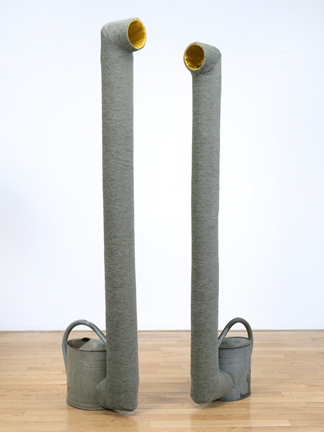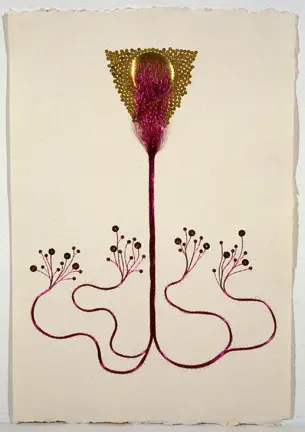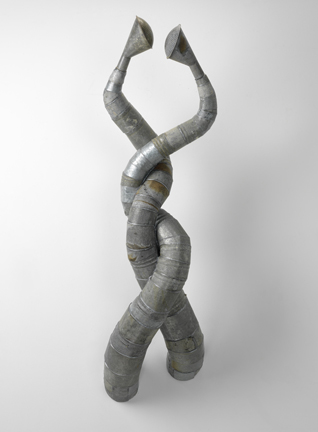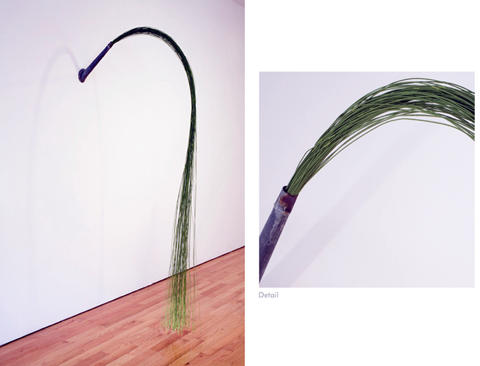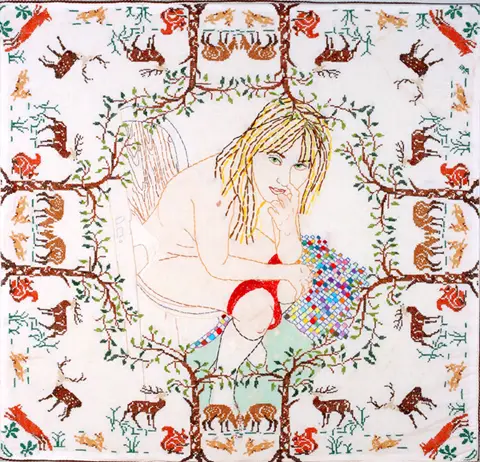This months Future Heirlooms is with the talented and unique Rachel Selekman. I have just recently been introduced to her work, by a fellow artist, and immediately felt an affinity toward combination of domestic tools and fiber. Her work has a beautiful simplicity and even minimalism to it while having great depth with its associations and high level of craft. I yet to meet Rachel but since we are both in Brooklyn hopefully we can amend that soon. Until then I am excited to share more about her work along with you. She has given is an incredibly wonderful interview. GO.
Nesting, 2002, Pocketbook frame, fabric, thread, velvet leaves, paper leaves, and chain, 38 x 24 x 21 inches
Where do you live?
I just moved to Bedford-Stuyvesant in Brooklyn, although I’ve lived in New York City for over 20 years. Having just moved, it’s a little too early to know how my new neighborhood will affect my work, but I’m sure it will as my life experiences always do.
If you had to describe your work in 3 words what would they be?
Wow, this is tough, but how about quirky, compelling, and enigmatic.
What is your background as an artist?
I’ve made things all my life; I’ve always worked with my hands. My formal education includes a BFA from the Maryland Institute College of Art and an MFA from the School of the Art Institute of Chicago (I went to the schools with the longest names).
Flowering Can, 2006, Watering can, fabric, thread, buckram, cardboard, ribbon-wire, glue, staples, plastic stem holders, flowers, and cable
Your work is very interesting in that it uses a mass produced metal object, the watering can, to talk about how humans interact and have or do not have intimacy. Can you talk about the symbolism of the watering can and its role in your work?
The watering can intrigues me on many levels, and its role in my work has developed since I first started using it in the late 1990s. In general, I select objects to incorporate in my sculptures that serve as stand-ins for me, in particular, or women, in general. The watering can is compelling for both its actual function and its metaphorical power. It’s an object used to provide sustenance to living things’make things grow and thrive’and this quotidian function is a quality often ascribed to women: nurturer and caretaker.
The first sculptures I made with watering cans, which included numerous multispouted ones, explored the idea of woman as nurturer, but also as a kind of busy multitasker, where the multiple spouts could be read as arms, breasts, and/or octopuslike tentacles. My current body of work, which looks at the dynamics of relationships, of intimacy’how people engage and interact; how they communicate, hear, listen, see, touch’still uses the watering can as a stand-in for the figure, but not necessarily female. For instance, in The Conversation, two ‘figures’ are in dialogue, and while for me they represent a man and a woman, they can be any gender.
Reach, 2006 Watering can and spouts, silicone sealant, and cable, 18½ x 41½ x 34¾ inches
How did you transition from the more direct association of the watering can to using it as a stand in for the human?
In all the sculptures, the watering can serves as a stand-in for the figure, but there was a shift between the multispouted watering can pieces I made around 2006, like Reach and Flowering Can, and the most recent ones. When I started working with the multispouted forms, which were very much about woman as nurturer, I couldn’t deny the spouts phallicness as well, and at that point I started thinking about the sculptures as a melding of female and male, or female with masculine and feminine attributes. From there, when I started working on the most recent body of work, gender specificness was less important to me.
Splash, 2010, Watering can, steel, fabric, thread, and hardware, 35 x 44 ¼ x 42 inches
How does the incorporation of fabric and sewing affect the conceptual aspect of your work?
Making work that is beautiful and sensual is very important to me, and fabric definitely contributes to the sensuality of my sculptures. Fabric is also part of our everyday experience and therefore imbues the work with a sense of the familiar, making it approachable and contributing to its surreal affect.
Sewing connects me to a tradition that spans millennia and cultures. It’s very ‘base,’ and links my work to the domestic as well as craft, both of which are associated with women. I like being part of that continuum. And I like the process of sewing, whether by hand or machine, as it allows me to not only build form, but also to make marks and create texture. It’s both meditative, when I’m engaged in a lot of repetitive, laborious hand sewing, and useful, when I’m just using my sewing machine as I would any other tool, to put a pattern together and make a form.
Mouth Wide Open
It seems as if your selection of fabrics is very careful and specific can you talk about the fabric choices you make and how you make them?
I begin every piece that incorporates fabric by using muslin to figure out the pattern and form. Through that process, I get to ‘know’ the sculpture and have time to contemplate what fabric I will use in the finished work. Sometimes I have a general sense of what I want before I start a piece. For example, in Mouth Wide Open I knew I wanted a gray fabric similar to the color of the can for the exterior to give the outside of the piece a unified feeling and I wanted a rainbowlike fabric for the interior. With other works, I don’t have a preconceived idea of what fabric I’ll use, but I trust that the process of making the piece will lead me to my fabric choice. I also go to fabric stores, look at and feel lots of fabrics, get samples, and then see how they look with the sculpture in progress. Fabric is great to work with as it has color, texture, and body.
Mouth Wide Open, 2009, Watering can, fabric, thread, interfacing, glue, steel, and hardware, 29 x 29 3/8 x 30 inches
Can you talk about the challenges you have faced in incorporating fabric with metal materials?
For me, the challenge isn’t marrying metal and fabric, it’s the technical aspects of making the sculptures: Creating the steel armatures and getting them to fit the can properly; making the patterns for the fabric elements (not having a background in garment construction, I’m always shooting from the hip when I have to make a pattern), and then putting these different elements together.
You have also done a gorgeous series of highly stitched pocket books, briefly tell us about the conceptual story of these works.
The pocketbook was the first everyday object I incorporated into my work and explored in depth. I selected it because it’s an object solely associated with women. The first pocketbook pieces, from the early 1990s, explored the idea of weight, both physical and emotional, as it pertained to women’s lives. But like the watering can it was a potent object that I worked with for many years and in many different manifestations, with my conceptual focus changing over time, too. The pocketbook also served as a stand-in for the body, as I really consider all my work to be figurative. While I haven’t used it in my work for a few years, I certainly don’t rule out using it again!
The Conversation, 2009, Watering cans, fabric, thread, buckram, interfacing, batting, glue, steel, and hardware, Larger: 76 3/8 x 8 ¼ x 27 ½ inches; smaller: 72 ¾ x 7 ½ x 21 inches
How has your work evolved since you first began working with fabric?
It’s evolved a lot, and often the evolution has been affected by the kind of studio facilities I did or did not have access to. For instance, I learned to weld in grad school and that process opened up a whole new way I could work with fabric, namely I could make steel armatures in any form I desired and then fit fabric to their interiors and exteriors. But when I returned to New York after grad school, I didn’t have welding facilities, so at first I was using fabric in mostly 2-D pieces, and then, later, I learned to build forms and use fabric by working primarily with materials associated with the textile industry, like buckram, interfacing, boning, etc. For the past few years, I’ve had access to welding facilities again, at the Educational Alliance on the Lower East Side, so I’ve been making the steel armatures for all the most recent sculptures there.
All artists are faced with studio constraints at one time or another, but if you look at them as opportunities and not roadblocks, you can end up discovering new ways of working and still make great work!
Pink Growth, 2005, Watering can spout, metal sequins, and metallic thread on paper, 24 x 15 3/4 inches
What is the next direction or step for your work?
I have a few more steel armatures that need to be turned into sculptures, and I have to make another armature for a new piece that is in keeping with the most recent work. But I’m also anxious to return to making some works on paper. Normally, I don’t have time to make sculptures and works on paper simultaneously, and much of the last few years has been spent working 3-D, so I want to spend some time working 2-D.
Describe your studio and studio practice.
My studio is a room in my new home. I’ve had live/work spaces ever since I got out of grad school, in part because of finances and how expensive New York City is, but also because I like being able to wake up and get right to work. I also enjoy working in the evening, so having a studio at home facilitates that too. Basically, my studio days are spent doing work that I need to think about ‘decision-making’ and evenings are spent doing work I don’t need to think about ‘sheer labor.
The Lovers, 2010, Watering can pieces and roses, silicone sealant, epoxy, wire mesh, buckram, and steel, 51 ½ x 14 ½ x 22 inches
Who are the 3 most inspiring people to you as an artist and why?
This too is a tough question, as it’s hard to narrow my selection down to only three, but to follow are my answers for today:
Louise Bourgeois. What can I say’her forms, her materials, her obsessions, her doggedness.
Petah Coyne. I’ve followed her work for years and, like me, she’s an object-maker. I admire her use of materials and how she transforms them to create sculptures that are beautiful, complex, sensual, and over-the-top.
Eva Hesse. Her works are a combination of the formal and the idiosyncratic, which is what I think makes them so great. She was also a pioneer in terms of material choices and explorations. Unfortunately, those very choices likely contributed to her early demise.
What else do you spend your time doing? Do any of these inform your work?
Right now I am settling into a new home, which is a process I very much like because I consider myself to be very domestic, a homebody. But when not in the throes of a move, I like to spend time with my husband, cook, see art, and get my exercise walking around Prospect Park with a friend.
As for work, I am the archivist and project coordinator at the Dan Flavin Estate. I’ve been at the job for just a year, but I’ve worked in the visual arts ever since I graduated from college. It’s a really interesting position, and I like having the opportunity to focus on one artist, unlike when I worked at galleries. And Flavin was active during a fascinating time in the New York art world, so that adds even more to the experience of learning about his work.
Of these things, seeing art is probably what inspires my work the most, particularly contemporary art. I love seeing what other artists are doing; it keeps me psyched to work in my studio.
Green Spray, 2006 Watering can spout, fabric-covered wire, wire crimpers, enamel paint, glass, glitter, glue, and brass mount, 90 x 14 x 43 inches
Give us an idea of a day in the life of you.
When I’m not at my job, I like nothing more than having a full day in the studio. Right now I am working on a big commission for three large-scale works on paper and there’s a very tight deadline, so there’s no messing around. It’s all work from at least 9 to 5.
Where can we see your work?
On my website (rachelselekman.com) you can see my work and in the ‘news’ section you can find out about upcoming shows and projects. In that section, too, I keep a running list of exhibitions to see, with a special focus on sculpture.
Thank you Rachel!!!!!!
Until next time keep stitching.
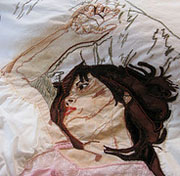
Joetta Maue is a full time artist and curator primarily using photography and fibers. Her most recent work is a series of embroideries and images exploring intimacy. Joetta exhibits her work throughout the United States and internationally, and authors the art and craft blog Little Yellowbird as well as regularly contributing regularly to Mr X. Stitch and the Textile Arts Center Blog. Joetta lives in Brooklyn, NY, with her husband, son, & two cats.

